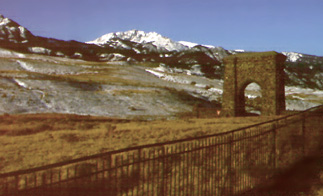

"It is a pleasure now to say a few words to you at the laying of the corner stone of the beautiful arch which is to mark the entrance to this park. Yellowstone Park is something absolutely unique in the world so far as I know. Nowhere else in any civilized country is there to be found such a tract of veritable wonderland made accessible to all visitors. . . ." With these words, President Theodore Roosevelt dedicated the arch at the North Entrance to Yellowstone National Park in a ceremony on April 24, 1903.
When Yellowstone was established in 1872 as the world's first national park, it was remote and nearly inaccessible. Few tourist had the time or the financial means to travel to Yellowstone. The railroad companies of the time played a large role in promoting the park and providing access from the major cities of the east and west coasts. By 1903, the Northern Pacific Railroad line had been extended to Gardiner, Montana, and the north entrance to Yellowstone was turned into a bustling tourist destination. From the crowded Gardiner train depot visitors would board stagecoaches and begin their "grand tour" of Yellowstone's wonders.
Captain Hiram M. Chittenden of the U.S. Army Corps of Engineers and director of road construction in Yellowstone, decided that the park's primary entrance deserved a formal gateway to improve and dramatize the appearance of the train depot's dusty staging area. Working from notes provided by Chittenden, architect Robert Reamer, designer of the Old Faithful Inn and Canyon Hotel (no longer in existence), designed and assisted in the planning of the project. Chittenden and Reamer called for extensive landscaping in the depot area and a large imposing arch built of local columnar basalt. The arch they designed and built rises 50-feet high in stark contrast to the surrounding area. On both sides of the arch, 12-foot high walls originally curved around a landscaped pond and garden. The arch, inscribed with the words: "For the Benefit and Enjoyment of the People," faced the Gardiner train depot welcoming visitors to Yellowstone.
By the 1940s train travel was replaced by the automobile. Not just the wealthy could come to Yellowstone now. Automobiles not only changed who could travel, they also changed how and where people traveled. Visitors now came through the East, South, and West entrances to the park; the North Entrance was no longer the primary route into the park. In 1948, train service to Gardiner ended, and an era of Yellowstone's visitation passed into history.
Today, the Roosevelt Arch still stands, and the words engraved across its face still welcome visitors to Yellowstone. The arch has become one of the great symbols of the "National Park Idea."
![]() Comments
and Questions are Welcome.
Comments
and Questions are Welcome.
This site is hosted by Geocities. Get your own Free Homepage.